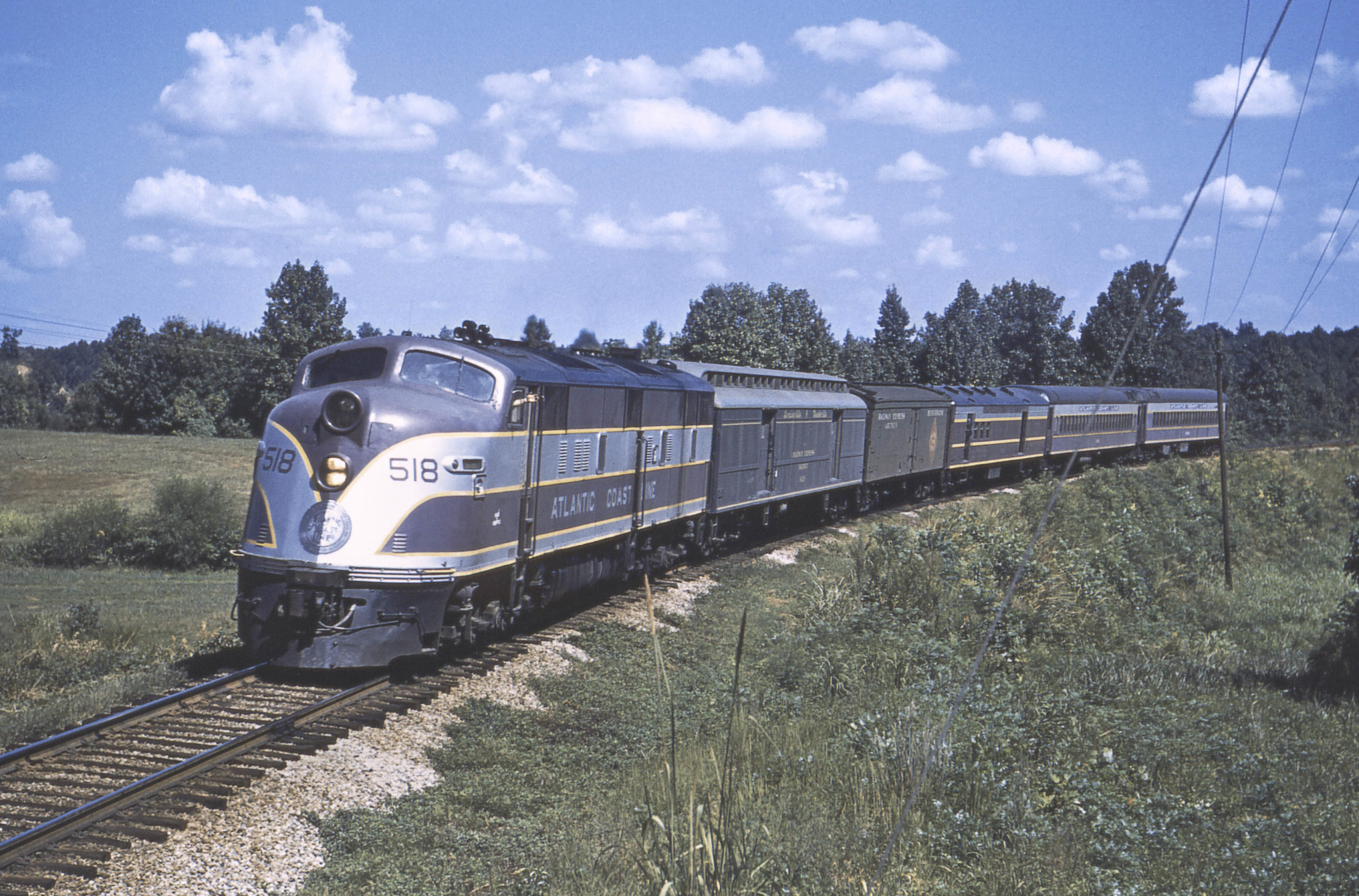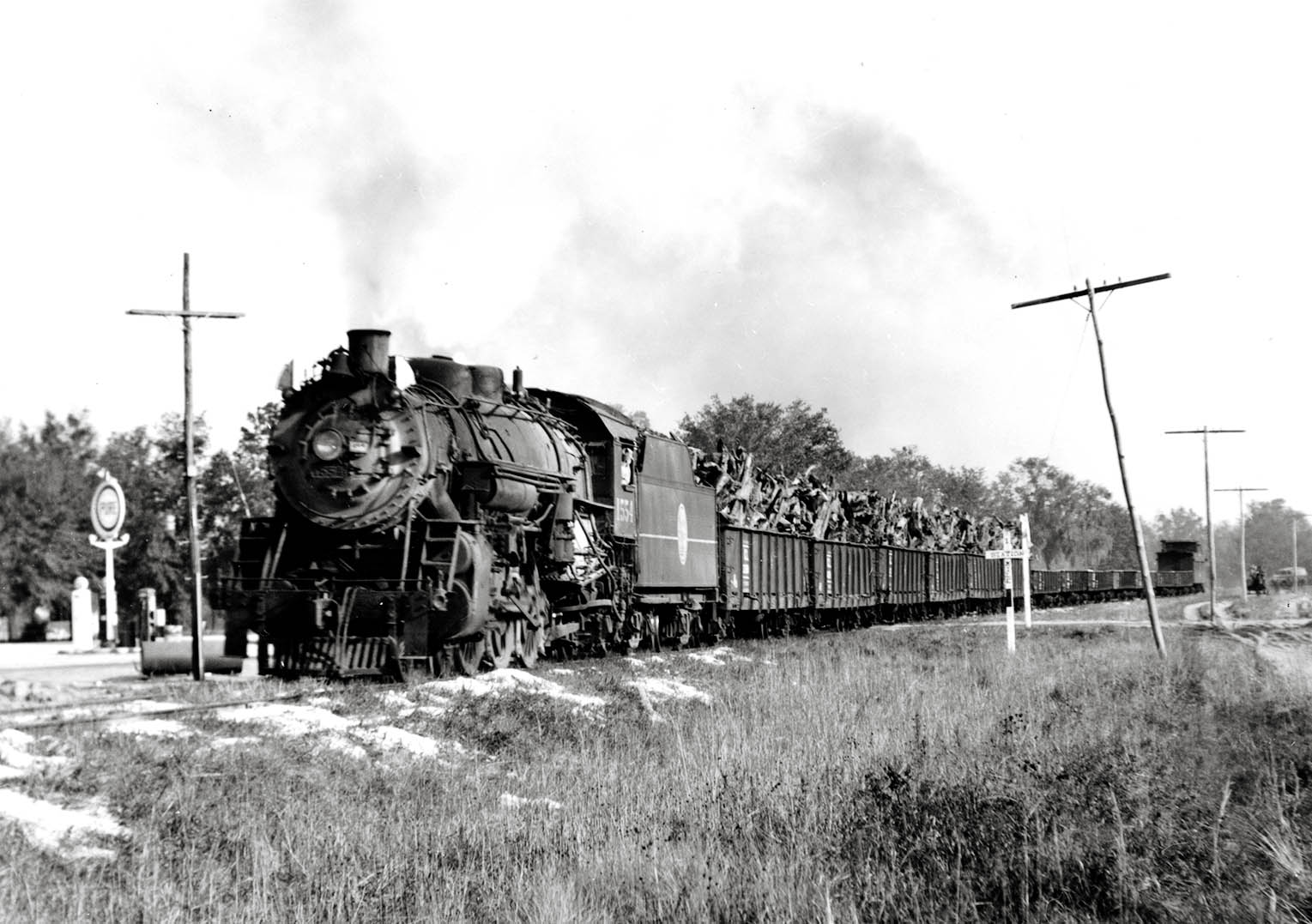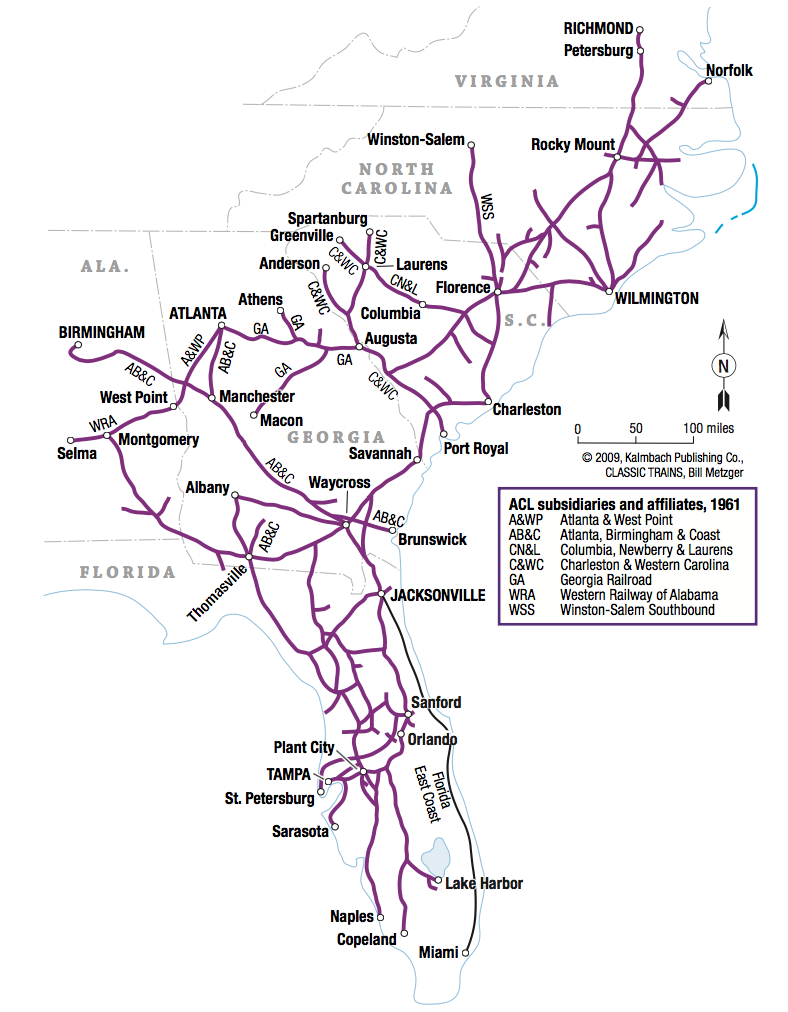The Atlantic Coast Line Railroad was true to its name: it linked an important string of coastal cities between Richmond, Va., and Florida, paralleling the Atlantic Ocean along the way. Its major traffic flows were north-south along the seaboard, and its New York to Florida passenger trains were widely known and heavily patronized for nine decades. But Atlantic Coast Line was also a major railroad holding company, and its “family” of lines stretched to Cincinnati, St. Louis, Memphis, and New Orleans.
This large, powerful system was one of several in the Southeast formed in the late 1800s. Like its rivals Southern Railway and Seaboard Air Line, Atlantic Coast Line was a creation of northern financiers who first wove together formerly separate companies through financial control, then merged them into one entity. Although ACL’s earliest predecessors dated to 1830 in Virginia (Petersburg Railroad) and 1834 in North Carolina (Wilmington & Weldon), not until after the American Civil War did real interest surface in forming a single north-south system. Baltimore bankers Benjamin F. Newcomer and William T. Walters began buying railroads that formed a route from Richmond to Charleston, S.C., with branches to the Atlantic on the east and Augusta, Ga., on the west. As early as 1871, advertisements began to appear labeling the combined route “the Atlantic Coast Line.”
Atlantic Coast Line is born
After three decades of common ownership and coordinated operations, most of the predecessors were brought together under one entity, Atlantic Coast Line Railroad Co., on April 23, 1900. (The 343-mile Charleston & Western Carolina, controlled after 1897, wasn’t merged into Atlantic Coast Line until 1959, along with 75-mile neighbor Columbia, Newberry & Laurens.) The new Atlantic Coast Line was financially robust from the beginning, and soon had taken control (through majority stock ownership) of the Louisville & Nashville, which stretched from the Ohio River and St. Louis to Atlanta and New Orleans. L&N, in turn, controlled the Nashville, Chattanooga & St. Louis, which ran from Atlanta to Memphis via Nashville. Linking L&N at Atlanta and Atlantic Coast Line at Augusta was another acquisition, the Georgia Railroad. Atlantic Coast Line and L&N jointly leased the “Georgia Road” and its affiliated companies, Atlanta & West Point and Western Railway of Alabama. Atlantic Coast Line essentially finished its route map with its 1902 purchase of the Plant System, reaching from Charleston, S.C., south to Jacksonville and Tampa, Fla., and west to Montgomery, Ala.
The Plant System provided the Coast Line with a well-located main line from Richmond to Florida. Merchandise, forest products, and Florida produce flowed rapidly along, augmented by sand and a growing volume of phosphate. For northeast Florida passengers, ACL was the route of choice. As early as 1888, Atlantic Coast Line gained notice with its seasonal Florida Special, advertised as the first New York–Miami all-Pullman flyer. Although Atlantic Coast Line never reached Miami, it established an early relationship with the Florida East Coast to forward its trains south from Jacksonville.
Rising fortunes in the Roaring ’20s
ACL’s fortunes continued to rise through the 1920s, and it was soon double-tracking its Richmond–Savannah main line and improving other routes. The “family” continued to grow, with a joint lease (with L&N) in 1925 of the Clinchfield (Spartanburg, S.C. to Elkhorn City, Ky.) and purchase in 1926 of the bankrupt Atlanta, Birmingham & Atlantic. Atlantic Coast Line renamed the AB&A as Atlanta, Birmingham & Coast, and kept it as a separately run property. The Y-shaped AB&C provided an important missing link between ACL’s south Georgia shop town and hub of Waycross with L&N at Birmingham and Atlanta. ACL’s “family lines” — a term first used in the 1920s and formally applied to the group in the 1970s — totaled more than 12,000 miles at peak, of which Atlantic Coast Line owned about 5,500.
ACL’s relatively flat profile let it make good use of a large fleet (235) of dual-service Pacific-type 4-6-2 steam locomotives, equally at home on fast passenger trains, long strings of refrigerator cars, or merchandise freight trains. ACL’s early steam locomotive roster also had many 4-6-0 Ten-Wheeler-types, which Atlantic Coast Line used in both passenger and light freight service, and 2-8-2 Mikado-type steam locomotives for long, slow drag freights. Its heaviest freight engines were 20 2-10-2s Santa Fe-type steam locomotives bought in 1926 for the up-and-down “Bow Line” from Waycross to Montgomery.
Relative prosperity in the Great Depression
As tourist travel picked up in the late 1930s, the Seaboard beat Atlantic Coast Line to the punch with both diesel-electric locomotives and streamlined passenger trains. Seaboard Air Line put colorful Electro-Motive Corp. E4-type diesel electric locomotives on its Orange Blossom Special passenger train in 1938, but the Atlantic Coast Line went back that year to Baldwin Locomotive Works of Philadelphia, for 12 huge 4-8-4 Northern-type steam locomotives. The Northern-type locomotives were fast and powerful, but had running gear problems and could not match the efficiency and servicing advantages of diesel-electric locomotives.
Diesel locomotives begin to appear
The Atlantic Coast Line changed course and bought two Electro-Motive E3 diesel electric locomotives in 1939, and painted them in aluminum and Royal Purple, colors long used on its passenger timetables and said to be favorites of up-and-coming Vice President Champion McDowell Davis.
The flashy new EMC E-type diesel electric locomotives were coupled to Atlantic Coast Line’s first lightweight passenger train in December 1939. Atlantic Coast Line named its train Champion. Champ Davis, who became Atlantic Coast Line president in 1942, remained a dedicated fan of purple, and by the mid-1950s the color adorned everything from passenger cars to maintenance-of-way cranes to depot trim.
Although Atlantic Coast Line was able to acquire only a few dozen diesel electric locomotives, mostly Electro-Motive E and FT types before 1945, it rapidly ramped up when restrictions on such purchases were lifted after the end of World War II. Larger numbers of Electro-Motive diesel locomotives arrived through the late 1940s, except for a few Alco and Baldwin-made diesel-electric switcher locomotives. In 1950 and 1951 alone, Electro-Motive delivered some 350 diesel electric locomotives. A few more came in 1952, and ACL’s roster of 564 diesels was complete; 154 were GP7 general purpose-type locomotives — Atlantic Coast Line had no need for GP9 general purpose-type locomotives. Steam locomotives were almost gone by 1952, but a few Pacific and Ten-Wheeler-type steam locomotives ran on two former AB&C branches in Georgia until 1955.
Atlantic Coast Line bought its first second-generation diesel-electric locomotives in 1963, nine Electro-Motive GP30 general purpose-type locomotives. These were followed shortly by new six-axle, high-horsepower models that EMD, GE, and Alco had just put in their catalogs. Atlantic Coast Line liked the six-axle locomotives, especially their ability to reduce the long strings of F-type and GP general purpose-type locomotives required on certain lines.
ACL updates after World War II
The Atlantic Coast Line bought a large lightweight car fleet after World War II, allowing the flagship Champions and Florida Special to be fully re-equipped for the 1949 to 1950 winter season. Atlantic Coast Line also completely rebuilt its heavyweight coaches to lightweight standards, and often used them on its premier runs. Besides the Florida headliners, Atlantic Coast Line also ran a strong network of secondary passenger trains, including through Pullmans to such destinations as Wilmington, N.C., and Naples, Fla.
Atlantic Coast Line bought thousands of new freight cars after World War II, many with roller bearings years before they became standard; Centralized Traffic Control signaling; train radio; and many other physical plant improvements. Like much of the industry, Atlantic Coast Line endured slim years in the late 1950s. It ceased operating dozens of local passenger trains, closed branch lines, and bought no locomotives and little rolling stock. In 1957, Champ Davis retired at age 78 and was replaced by W. Thomas Rice, the young president of the RF&P. Rice promptly ended the maintenance-intensive purple paint scheme and replaced it with basic black, albeit with aluminum lettering and yellow striping.
Merger talks with rival Seaboard
Perhaps Rice’s greatest departure from Atlantic Coast Line orthodoxy was his immediate merger overture to arch-rival Seaboard. The proposal reflected growing recognition that the railroads’ most serious competitors were outside the industry. Even though Atlantic Coast Line lost its longtime Miami partner when a protracted strike took Florida East Coast out of the through passenger business in 1963, Atlantic Coast Line quickly arranged to use a combined ACL-SAL alternative route through central Florida and the two railroads eventually merged.
At first, little trackage was abandoned, but by the 1980s some former Seaboard main lines had been taken up or severed. Seaboard Coast Line kept the best passenger trains of both predecessors, and by the time of Amtrak’s 1971 inception, had become known as one of the few remaining pro-passenger carriers.

















I grew up in Piedmont NC, Southern Rwy. territory. My first trip to a beach (Ocean Drive, SC) was summer of 1951 as a ten year old. Dad was driving us south on NC 87 between Sanford and Fayetteville when I caught a glimpse of purple on a parallel railroad. It was an EMD yard switcher (SW-1 maybe) running backwards southbound toward Fayetteville with a short consist. When I got back home, my research revealed this was an ACL engine running on the former Atlantic & Yadkin Rwy. (nee Cape Fear & Yadkin Valley). Thank you Mr. Davis for that lovely purple and thank you Larry for the great article on a Southeast favorite.
Just found this and wanted to comment. Parents and I rode ACL from Jacksonville, FL to Punta Gorda to visit my aunt. We had to change trains at Lake Alfred at 4 am, Mom hardly slept because she did not want to miss the stop, but conductor came thru and made sure we got off. Easy step from one train to another. Coming home in reverse, but this time the change was about midnight, we rode in a combo car with coach seats and another section for baggage. That was a long haul, we had to catch IC out of St. Louis, change trains at Carbondale, IL to another IC at midnight. We were glad to see the Mars light blinking as the train from Chicago arrived. Switch over to C of G at Birmingham, but we did not have to get off and that RR took us to Jacksonville. Can remember seeing a chain gang of prisoners doing road work someplace in GA as we passed by, the guards were on horses. We were riding on Dad’s free pass, so not a direct trip. My grandpa had went down a few months earlier on same route, but never left the train, switched over, but he was a revenue passenger. I can remember the purple engines on ACL, very different from anything I have ever seen.
Enjoying the sketch on the ACL. My father often rode the Champion from Philadelphia or Washington DC to Jacksonville in the ’50’s, after it had become a sleeper train. I have to admit that I’m a bit surprised that the second passenger diesel purchased by the ACL; E-3 #501, now resident at the North Carolina Transportation Museum, and one of the “stars” of “Streamliners at Spencer” a few years back, hasn’t been pictured anywhere in this article. (It’s sister ACL 500 was apparently destroyed in a wreck in the early 1950’s). I happen to live in Janesville, WI; and when the 501 was privately owned by Glen Monhart it was stored in the former Milwaukee Road (now Wisconsin and Southern) roundhouse here, and was used to pull a few excursions on the then Wisconsin and Calumet. It also appeared at the EMD 75th anniversary celebration in LaGrange, and I believe was the oldest EMD product there. Hopefully this important relic of ACL’s history will make it into the articles going forward.
I hired out on SCL in Feb. ’73, at Hialeah Yard (Miami), former SAL territory. In ’75 I transferred to Waycross, Georgia, former ACL territory. I was asked “Are you a Coast Line man or a Seaboard man?” This was 8 years after the ACL/SAL merger!
President Rice was known as “The Purple Diesel Eater.” (At the time, there was a popular song “The Purple People Eater.”
I grew up in Plymouth, NC. ACL served the area along with Norfolk Southern. The OLD ACL station on the Roanoke Rivet is now a museum.